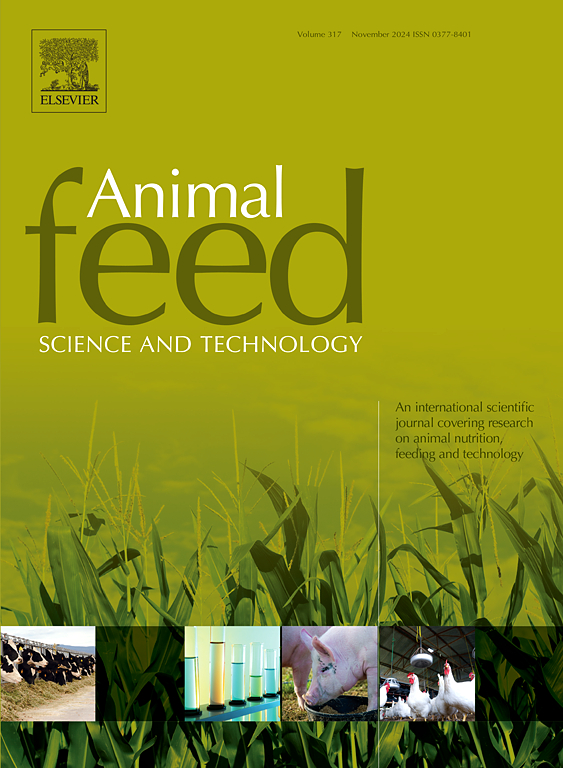饲粮中添加海藻酸钠对薄唇灰鲻鱼种生长、免疫、抗氧化生物标志物、组织结构和热应激耐受性的影响
IF 2.5
2区 农林科学
Q1 AGRICULTURE, DAIRY & ANIMAL SCIENCE
引用次数: 0
摘要
本试验的主要目的是探讨饲粮中添加水平分别为0.0 % (SA0)、1 % (SA1)、2 % (SA2)和3 % (SA3)的海藻酸钠(SA)对薄唇灰鲻鱼种生长性能、免疫和抗氧化生物标志物以及内脏(肝脏、鳃和肠道)结构的影响。鱼(6.25 ± 0.20 g)饲喂试验饲料至表观饱腹,每天3次,连续饲喂10周。之后,通过将鱼突然暴露于32 °C来研究高温应激耐受性,并在4 h内记录它们的死亡率和死亡时间。结果表明,添加2 % SA可显著提高拉马达鱼的生长性能和饲料利用率。不同鱼种间胴体化学成分无显著差异。与其他SA组相比,高水平SA(3 %)诱导葡萄糖、尿素、肌酐、天冬氨酸转氨酶和丙氨酸转氨酶的水平最高。与其他SA组相比,SA2组的免疫和抗氧化生物标志物(2 % SA)水平明显较高。饲喂SA0、SA1和SA2的拉马达乳杆菌鱼种的肝脏、鳃和肠道组织组织学检查显示,其组织结构正常,但SA3组有轻微变化。热疗应激试验后,注意到对照组(SA0)在13 - 44 min开始死亡,需要115-132 min才完全死亡。另一方面,用SA饲料饲喂薄唇鲻鱼鱼种;特别是2 % SA,表现出更高的生存能力,并且需要更长的时间完全死亡(>180 min)。综上所述,在饲料中添加2 % SA可提高拉马达月牙鲆的生产性能、免疫和抗氧化能力,并增强其对高温应激的耐受能力。本文章由计算机程序翻译,如有差异,请以英文原文为准。
Effects of dietary sodium alginate on growth, immune, antioxidant biomarkers, histological structure, and hyperthermia stress tolerance of thin-lip grey mullet (Liza ramada) fingerlings
The primary goal of this experiment was to explore the consequences of dietary supplementation of sodium alginate (SA) at levels of 0.0 % (SA0), 1 % (SA1), 2 % (SA2), and 3 % (SA3) on growth performance, immune and antioxidative biomarkers, and internal organs (liver, gills, and intestine) architecture of thin-lip grey mullet (Liza ramada) fingerlings. Fish (6.25 ± 0.20 g) were fed on the experimental diets up to apparent satiety thrice a day for 10 weeks. After that, hyperthermia stress tolerance was investigated via sudden exposure of fish to 32 °C where their mortality rate and the time of death were recorded throughout 4 h. The findings herein showed that feeding L. ramada with 2 % SA significantly exhibited the best fish growth and feed utility. However, no significant alterations were registered in the carcass chemical composition among different fish groups. Compared with other SA groups, the high level of SA (3 %) induced highest levels of glucose, urea, creatinine, aspartate aminotransferase, and alanine transaminase. The immune and antioxidant biomarkers in the SA2 group (2 % SA) displayed noticeably higher levels compared with other SA-fed fish groups. The histological examination of liver, gills, and intestine tissues of L. ramada fingerlings fed on SA0, SA1, and SA2 diets showed normal histological structure but slight alterations were observed with SA3 group. After the hyperthermia stress test, it is noted that the control group (SA0) started to die at 13 – 44 min and needed 115–132 min to die completely. On the 0ther hand, feeding thin-lip mullet fingerlings on SA diets; particularly 2 % SA, showed higher survivability and needed more time to die completely (>180 min). In conclusion, using 2 % SA as a feed supplement in diets for L. ramada induced better performance, immune and antioxidant capacity, and enhanced their tolerance against possible hyperthermia stress.
求助全文
通过发布文献求助,成功后即可免费获取论文全文。
去求助
来源期刊

Animal Feed Science and Technology
农林科学-奶制品与动物科学
CiteScore
6.00
自引率
6.20%
发文量
266
审稿时长
3 months
期刊介绍:
Animal Feed Science and Technology is a unique journal publishing scientific papers of international interest focusing on animal feeds and their feeding.
Papers describing research on feed for ruminants and non-ruminants, including poultry, horses, companion animals and aquatic animals, are welcome.
The journal covers the following areas:
Nutritive value of feeds (e.g., assessment, improvement)
Methods of conserving and processing feeds that affect their nutritional value
Agronomic and climatic factors influencing the nutritive value of feeds
Utilization of feeds and the improvement of such
Metabolic, production, reproduction and health responses, as well as potential environmental impacts, of diet inputs and feed technologies (e.g., feeds, feed additives, feed components, mycotoxins)
Mathematical models relating directly to animal-feed interactions
Analytical and experimental methods for feed evaluation
Environmental impacts of feed technologies in animal production.
 求助内容:
求助内容: 应助结果提醒方式:
应助结果提醒方式:


